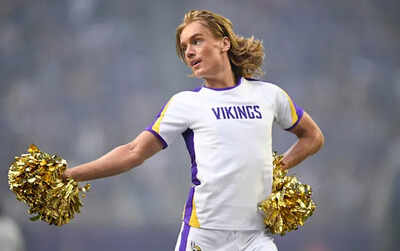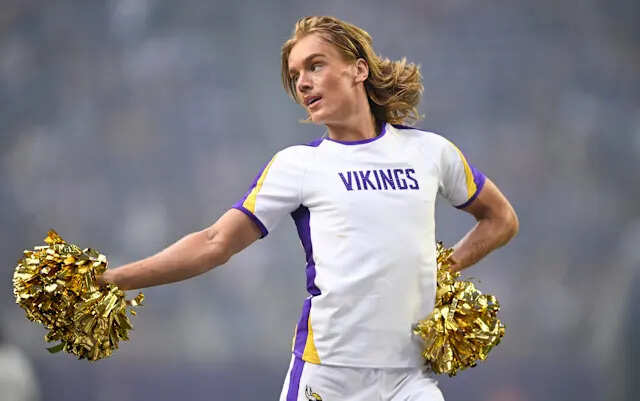ARTICLE AD BOX

Male cheerleaders are challenging traditional notions of athleticism in the NFL, bringing a blend of strength, agility, and artistry to the sidelines. This shift is reshaping football culture, promoting inclusivity, and redefining masculinity. Their presence attracts younger audiences and inspires broader participation in cheerleading, signaling a more diverse and evolved future for the sport.
When you think of the NFL, the images that pop into your head are pretty predictable: massive linemen slamming helmets, quarterbacks launching bombs, or maybe the iconic halftime show with pop stars stealing the stage.
But look a little closer to the sidelines, and you’ll see a quieter revolution happening — one that doesn’t involve touchdowns or tackles.We’re talking about male NFL cheerleaders.Yes, they’re here, they’re athletic, and they’re starting to chip away at one of the most rigid ideas in American sports: what athleticism looks like and who gets to own it.For decades, the NFL’s version of cheerleading has been a hyper-feminine space — pom-poms, high kicks, and a heavy dose of glamour.
Men, if they were present at all, existed in the shadows as stunt lifters or mascots, not as the stars. That changed in 2018 when Quinton Peron and Napoleon Jinnies joined the Los Angeles Rams as the league’s first male dancers. Other teams, like the New Orleans Saints and the Seattle Seahawks, quickly followed suit.

Vikings' male cheerleaders spark fresh debate on masculinity in NFL (Image via Getty)
But here’s the thing: being a male NFL cheerleader isn’t just about showing up on the sidelines. It’s a test of athletic versatility.
These guys combine strength, agility, and stamina in ways that rival what’s happening on the field. Think flips, tosses, breakneck choreography, and the stamina to perform under the same bright lights and brutal scrutiny as the players.Athleticism here isn’t about crushing an opponent — it’s about lifting teammates into the air while keeping rhythm to a pounding bassline.
Shaking up football culture
Football culture in North America has always leaned heavy on tradition: toughness, grit, and the image of the stoic warrior.
Cheerleaders, traditionally female, were slotted into the background, meant to amplify the spectacle rather than redefine it.Male cheerleaders disrupt that script. Their presence says that the sidelines are not just about beauty, but about skill. About performance. About athleticism that doesn’t look like a linebacker’s, but still demands extraordinary training and discipline.And let’s be real: that disruption rattles some fans. When Peron and Jinnies debuted, Twitter lit up with equal parts applause and vitriol.
Critics said male cheerleaders didn’t “belong” in football. Supporters fired back that athleticism comes in many forms — and maybe it’s about time football culture caught up.For LGBTQ+ athletes especially, the presence of male cheerleaders in the NFL is no small deal. The league has long battled criticism for being slow to embrace inclusivity. Male cheerleaders offer visibility, showing younger athletes that there’s room for them — not just as players, but as performers in the broader sports ecosystem.And it’s not only about representation in sexuality or gender. It’s also about broadening the definition of masculinity in football. Why should athleticism only be measured by bench press records or tackling power? Strength, coordination, and artistry are just as vital.
The business of breaking stereotypes
Here’s where it gets even more interesting: sponsors and brands have started to notice. Male cheerleaders change the visual landscape of NFL sidelines.
They add variety, they spark conversation, and they signal to fans that the NFL — often criticized for being stuck in the past — is at least trying to evolve.From a business perspective, it’s smart. Inclusivity attracts younger audiences who want their sports to reflect their values. Diversity sells, especially in an era when fans are as likely to follow athletes for their TikTok dance routines as for their highlight reels.
Why it matters beyond the NFL
The ripple effect is already spreading. Colleges and high schools in the US are reporting more boys signing up for cheerleading squads, inspired by the visibility on NFL sidelines. Across the UK and Canada, where cheerleading is still carving out its space, the idea of men on the squad is suddenly less radical.By redefining athleticism in the NFL, male cheerleaders are also reshaping how sports culture is imagined for the next generation.
They’re showing that you can be powerful without tackling someone to the ground. That grace can be as demanding as grit. And that masculinity — in sports and beyond — doesn’t have to fit into one narrow box.So, do male NFL cheerleaders redefine athleticism in football culture? Absolutely. Not because they out-lift or out-run the players, but because they prove athleticism is about more than brute force. It’s about strength married to coordination, endurance blended with artistry, and courage displayed in a space that wasn’t designed for them.They’re not just cheerleaders. They’re cultural disruptors, performance athletes, and a reminder that football’s future might look a little different — and a lot more inclusive — than its past.And if that shakes up the old guard of football culture? Well, maybe that’s exactly the point.



.png)
.png)
.png)
















 1 hour ago
4
1 hour ago
4









 English (US) ·
English (US) ·